We spent $470 on a Michelin-star meal for 2. The restaurant was inside a corporate office building, but our dinner was far from boring.
Tiffany Leigh

- I ate at Hansik Goo, a restaurant in Hong Kong known for modern Korean cuisine, for the first time.
- The delicious meal included seafood, pork dishes, sorbet, and tea.
As a food writer visiting my ancestral home in Hong Kong, I knew I wanted to try Hansik Goo, the region's only Michelin-star Korean restaurant.
Hansik Goo serves lunch, dinner, and drinks and specializes in modern Korean cuisine.
The restaurant, which has maintained its Michelin star for three consecutive years, also welcomed a new head chef last year, so I was excited to try the food.
During my visit to Hong Kong, a friend and I went to Hansik Goo for dinner to see what all the hype was about. Here's what our dining experience was like.
The exterior and interior of the restaurant were a little underwhelming to me.
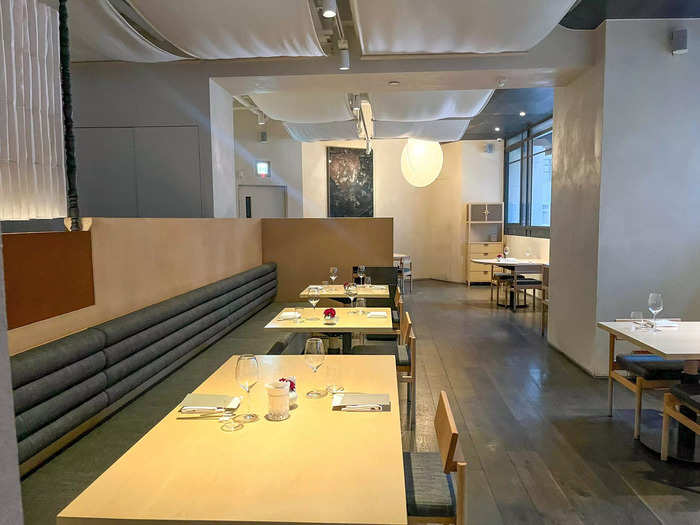
Hansik Goo is located inside The Wellington, a corporate office in Central, Hong Kong. We visited the restaurant on a Thursday at dinnertime.
From the outside, the plain brown building looked like anything but a home for an award-winning restaurant. When we walked in, I asked security to point us in the direction of the restaurant, which was on the building's lower level.
When we entered Hansik Goo, I noticed the dining area's walls were mostly bare and adorned with only a few paintings. It reminded me of a modernist art gallery.
According to Hansik Goo's website, the restaurant's decor aims to blend traditional Korean heritage with a contemporary design. But aside from the blonde-wood tables and seating, I thought the space felt sparse.
We started the meal with a selection of Korean beverages.
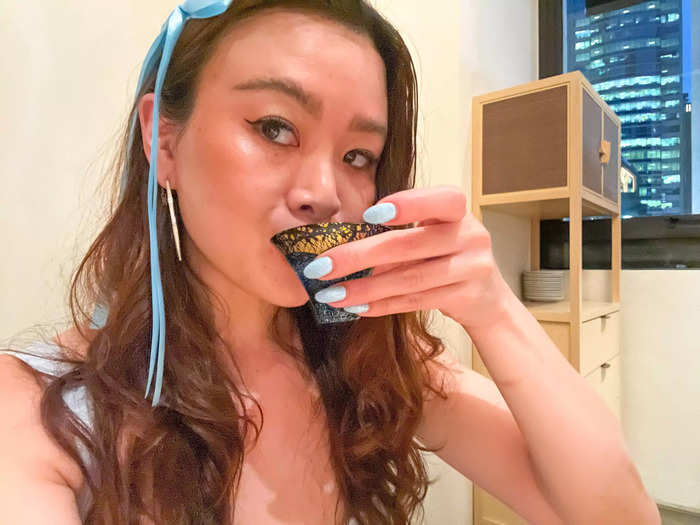
We wanted to familiarize ourselves with the beverages at Hansik Goo, so we ordered the Korean Sool drink trio for about 390 Hong Kong dollars, or $50.
I started with the Boksoondoga makgeolli, which reminded me of Champagne, and the Omegi Malgunsool, a liqueur with an assertive flavor profile that tasted a little harsh but was balanced with a natural fruitiness. I also tried Hwayo 25, a smooth soju made with Korean rice.
If given the chance, I'd probably order the Boksoondoga makgeolli again, as I could see myself sipping it at a bar.
After our drinks, it was time for our meal. We opted for Hansik Goo's 11-course tasting menu, which was HK$2,960.
We started our meal with jatjeuptang, a crab-and-pine-nut soup.
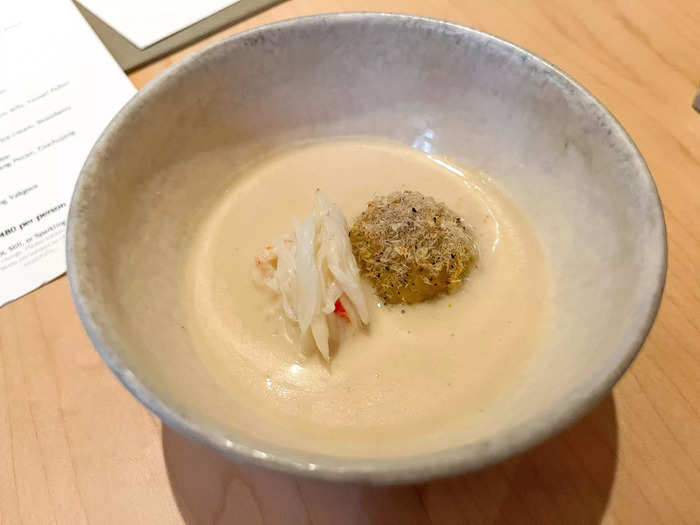
This dish consisted of wanja (a crab, Korean zucchini, and onion meatball) and crab meat in a creamy soup made with pine nuts.
I initially thought the crab itself was a bit salty. But after a few bites, its sweetness balanced the salt.
Next, I tried the seasonal spring bite.

The restaurant's spring bite had slices of surf clam topped with a lemony sancho-pepper dressing and caviar.
As I ate, I tasted the sweetness of the seafood, the spiciness of the dressing, and the saltiness of the caviar.
I liked the naengchae's tangy, salty, and sweet notes.
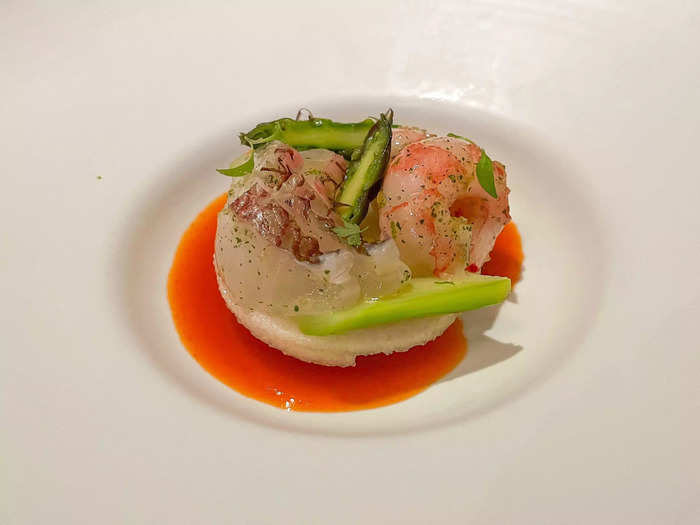
This course paired raw prawns and white snapper with pieces of Asian pears.
The seafood played off the sweetness of the fruit and the spicy, vinegary heat of the gochujang (red-chile paste) very well.
The abalone mandu was tasty and comforting.
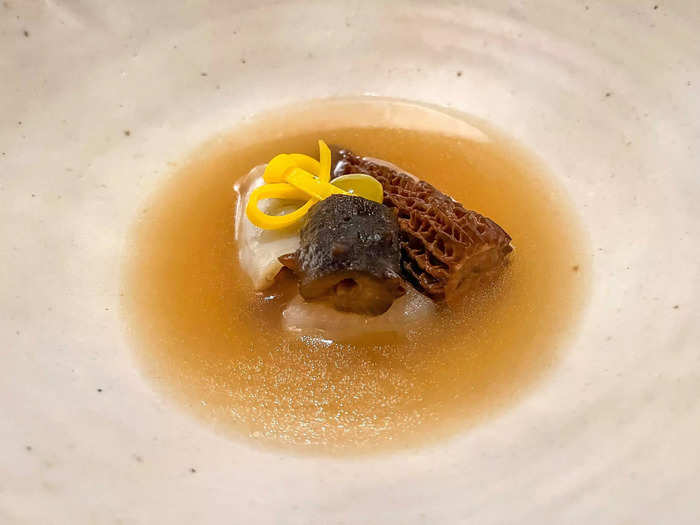
This dish included an abalone-wrapped dumpling paired with morel mushrooms, sea cucumber, and beef broth.
The meal was comforting and hearty and reminded me of the dumplings my grandmother used to make. Umami notes burst from every component on the plate.
I was a fan of the sweet-and-salty flavors in the saeng seon gui.
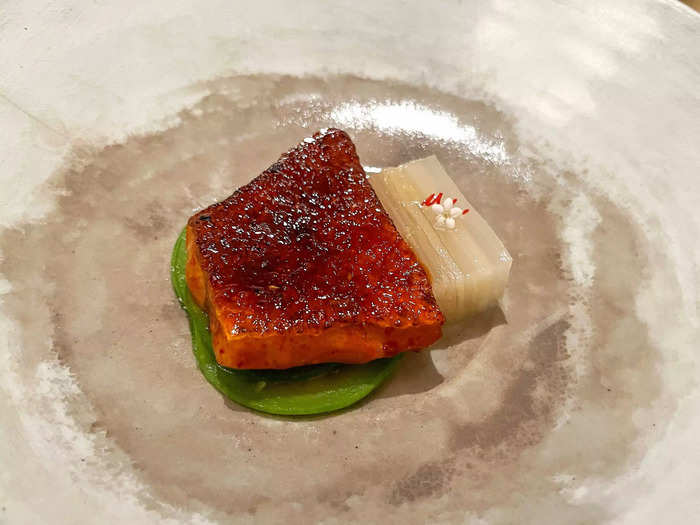
This dish included grilled gochujang black sea perch and layered white kimchi.
The fish was slightly salty and had a firm, flaky texture that reminded me of mackerel. The thin layer of sweet glaze on top of the fish perfectly balanced the dish.
The samgye yakbap had a great mix of savory and herbaceous flavors.
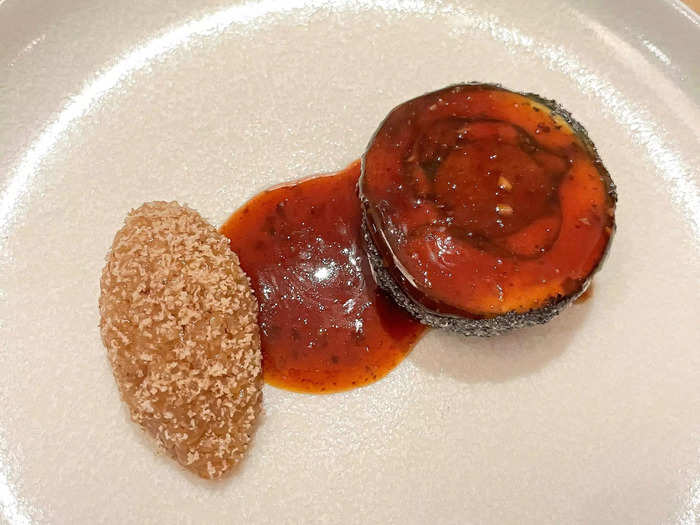
This meal was presented as a chicken roulade (a protein that's been pounded out, flattened, and served in the form of a roll) and rice infused with ginseng.
The juicy chicken was the perfect contrast to the sticky, herbaceous rice.
The hanwoo dish featured rich beef and a kimchi-and-cucumber salad.
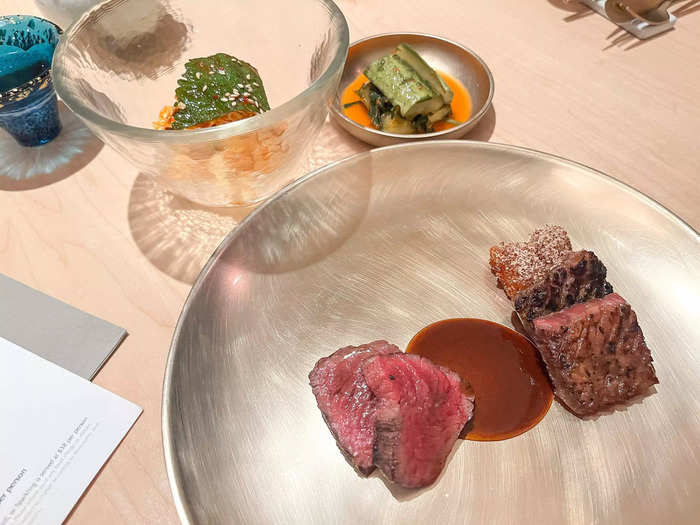
Our server told us this course, served alongside spicy kimchi and pickled cucumbers, was made with Korean-raised beef.
The meat's richness reminded me of wagyu beef, as it was hefty, fatty, and sweet. I liked how the kimchi and cucumbers cut through the decadence of the beef.
The dish was simple, but I thought the chef executed it so well.
I found the namul bibimguksu dish refreshing.
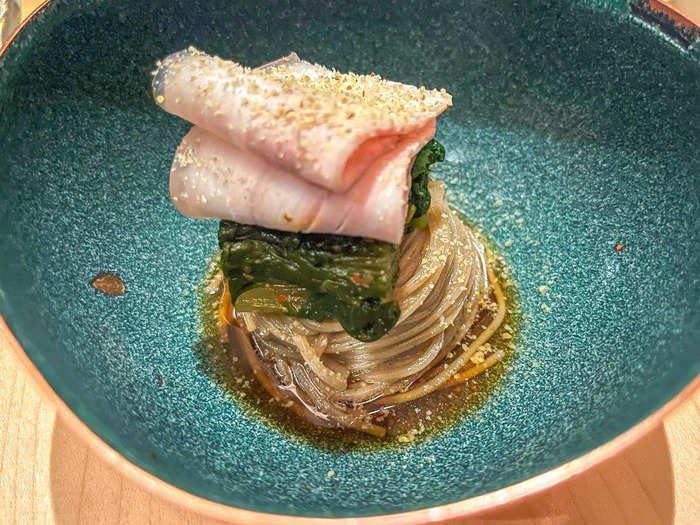
Next, we tried the namul bibimguksu, which was served with buckwheat noodles and draped with thin slices of pork belly.
I thought it was a cold, light, refreshing final dish before any sweet courses.
We added a half order of the galbi-jjim to our meal.
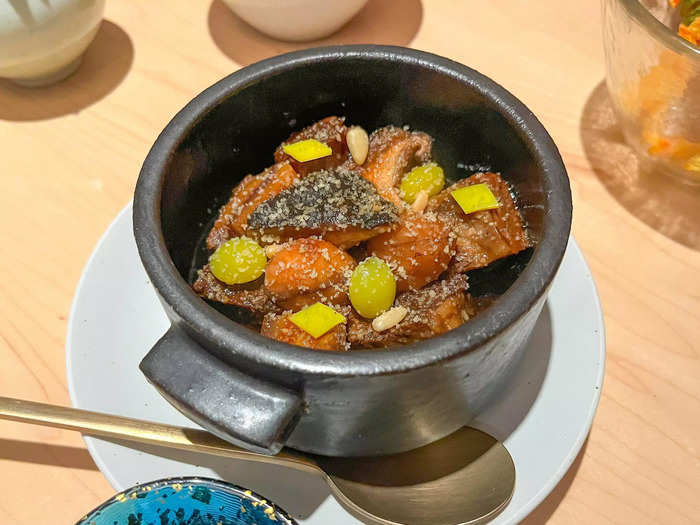
Though the tasting course included plenty of food, we also wanted to try the galbi-jjim, a type of beef stew. So, we added a half order for an extra HK$220.
This stew contained pieces of braised-beef short ribs and ganjang (a Korean soy sauce made with fermented soybeans and brine).
The caramelized sugar and fat from the meat and the mild saltiness from the broth nicely contrasted each other.
Before dessert, we were served the cham-oe, a sorbet.
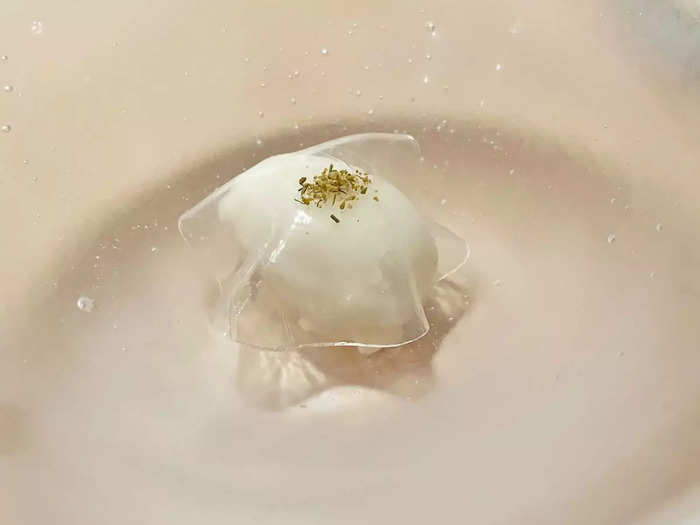
Before dessert, we had the cham-oe, made with Korean melon sorbet, sauvignon-blanc jelly, and fennel pollen.
It was a good, fruity palate cleanser before dessert.
The desserts were refreshing, satisfying, and not overly rich.
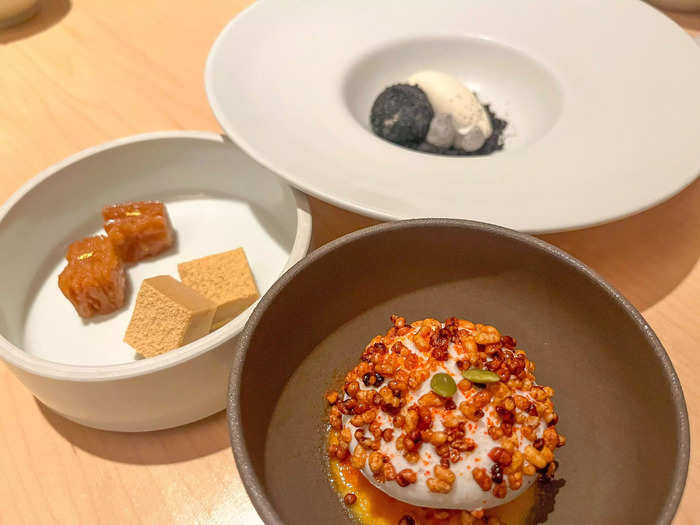
The tasting menu included two desserts: heukyimja, a black-sesame mousse with makgeolli ice cream and strawberries, and dagwa, which came with chocolate rice cakes, ginger-and-honey pastries, and Korean mulberry-leaf tea.
In addition to these pastries, we added the jang trio dessert course for about HK$70. This part of the meal included a doenjang (soybean paste) crème brûlée topped with ganjang pecans and gochujang powder.
Both the jang trio and the heukyimja tasted balanced and not too sweet, with a mix of savory, crunchy, and spicy components. The whirlwind of textures and flavors was delicious.
The pastries that came with the dagwa course were dainty, but I was too full to try any at the restaurant. However, my friend took this dessert home — she said the pastries were on the sweeter side but enjoyable with hot tea.
The meal was incredible, and I'd definitely return to Hansik Goo.
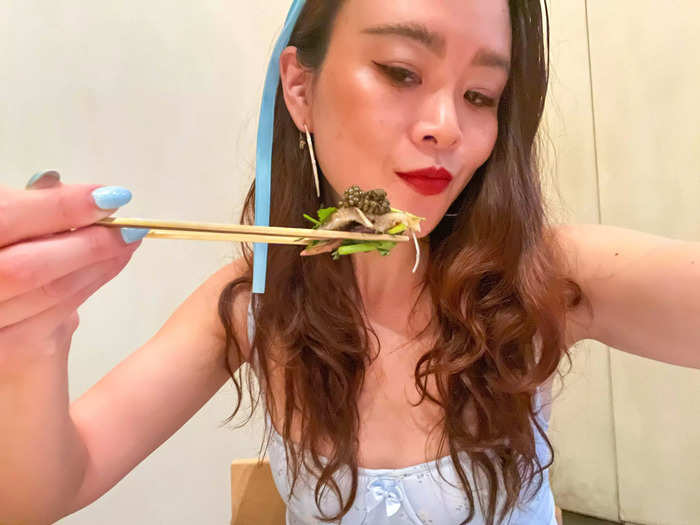
This meal was a splurge, but I felt the quality of each dish made it a good value. Including add-ons, the meal came out to about HK$3,640, or $470, before the 10% service charge.
The tasting menu did a great job showcasing modernist South Korean cuisine, with sophisticated yet subtle cultural homages to traditional dishes. The meal was teeming with flavor and had a range of textures, from delicate and light to hearty and robust.
Though I was worried about the amount of food, the portion sizes were just right, so I wasn't feeling uncomfortably full by the end of the night.
Our dinner was worth every penny, and I wouldn't hesitate to dine here again. From start to finish, the service was well-paced and informative, and every dish was memorably delicious.
Popular Right Now
Popular Keywords
Advertisement